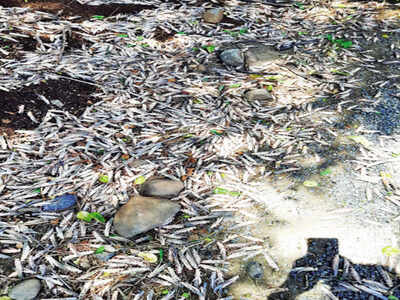
NAGPUR: Swarms of desert locust were spotted for the first time in Vidarbha two days ago in Amravati district. One was seen in Katol tehsil of Nagpur district on Monday evening from where it has now vanished.
So far there has been no major loss as there are no standing crops at this time. “The next location can be known after sundown,” said officials of the state’s agriculture department.
Locusts continue to be a threat to vegetation in general, according to agriculture department sources. Originally found in arid areas of Indo-Pak border, they are migratory pests.
Officials accept that their numbers are huge and not much can be done to eliminate them. Farmers have been sent advisories not to panic and shoo them away by making noise. “It is hoped they will terminate in natural course. If they do not, they may even end up finishing the vegetation they do not prefer to eat,” they said.
“The swarms were huge. In one area it was reported to be over 17km long and 2.5km wide,” said Ravindra Bhosle, the joint director agriculture (JDA), for Nagpur division.
There are no standing crops in the fields. “There were some vegetables in small pockets which were damaged. The locusts were seen on orange orchards but did not damage the plants leaves. This is because the pest does not prefer the bitter taste. It was seen on neem trees but did not damage the foliage,” said Bhosle.
The pest had flown into Warud and Morshi tehsils of Amravati through Betul in Madhya Pradesh and then reached Nagpur and Wardha districts. “We had received a warning a week ago from the central and state agriculture ministry. However, we did not expect it would reach here so fast. We were prepared though,” said Bhosle.
“Fire fighting continued throughout the night. Fire tenders were used to spray chemicals to kill the locust. This helped. Now the next location will be tracked,” said the official. Bhosle shared pictures of scores of dead locust after the spraying.
Bhosle accepted it may not be possible to wipe out the swarms soon. Farmers have been advised to apply neem paste as locusts do not like bitter leaves.
Sources said the swarms may turn to other leaves in the forest areas if they do not get crops which are its regular diet.
Subhash Nagre, JDA (Amravati), said locust are expected to have been feeding on the grass near Upper Wardha irrigation project. “There was no tangible loss to crop,” he added.
Manoj Jawanjal, an orange grower form Katol, said farmers of the area had a close shave from disaster. “Except vegetables grown by 10% of the farmers, there was no loss. The orange trees were saved too,” he said.
Jawanjal added that he had heard that locusts had left mango trees bare at Morshi in Amravati. “The pest has left the area,” he said.
So far there has been no major loss as there are no standing crops at this time. “The next location can be known after sundown,” said officials of the state’s agriculture department.
Locusts continue to be a threat to vegetation in general, according to agriculture department sources. Originally found in arid areas of Indo-Pak border, they are migratory pests.
Officials accept that their numbers are huge and not much can be done to eliminate them. Farmers have been sent advisories not to panic and shoo them away by making noise. “It is hoped they will terminate in natural course. If they do not, they may even end up finishing the vegetation they do not prefer to eat,” they said.
“The swarms were huge. In one area it was reported to be over 17km long and 2.5km wide,” said Ravindra Bhosle, the joint director agriculture (JDA), for Nagpur division.
There are no standing crops in the fields. “There were some vegetables in small pockets which were damaged. The locusts were seen on orange orchards but did not damage the plants leaves. This is because the pest does not prefer the bitter taste. It was seen on neem trees but did not damage the foliage,” said Bhosle.
The pest had flown into Warud and Morshi tehsils of Amravati through Betul in Madhya Pradesh and then reached Nagpur and Wardha districts. “We had received a warning a week ago from the central and state agriculture ministry. However, we did not expect it would reach here so fast. We were prepared though,” said Bhosle.
“Fire fighting continued throughout the night. Fire tenders were used to spray chemicals to kill the locust. This helped. Now the next location will be tracked,” said the official. Bhosle shared pictures of scores of dead locust after the spraying.
Bhosle accepted it may not be possible to wipe out the swarms soon. Farmers have been advised to apply neem paste as locusts do not like bitter leaves.
Sources said the swarms may turn to other leaves in the forest areas if they do not get crops which are its regular diet.
Subhash Nagre, JDA (Amravati), said locust are expected to have been feeding on the grass near Upper Wardha irrigation project. “There was no tangible loss to crop,” he added.
Manoj Jawanjal, an orange grower form Katol, said farmers of the area had a close shave from disaster. “Except vegetables grown by 10% of the farmers, there was no loss. The orange trees were saved too,” he said.
Jawanjal added that he had heard that locusts had left mango trees bare at Morshi in Amravati. “The pest has left the area,” he said.

Coronavirus outbreak
Trending Topics
LATEST VIDEOS
City
 Covid-19 crisis: Frustrated with living in containment zones, mob attacks cops in Rourkela
Covid-19 crisis: Frustrated with living in containment zones, mob attacks cops in Rourkela  Migrant workers sent back to their native place in Uttar Pradesh from Maharashtra in a special train
Migrant workers sent back to their native place in Uttar Pradesh from Maharashtra in a special train  AP: Domestic flight services resume at Visakhapatnam airport
AP: Domestic flight services resume at Visakhapatnam airport  Nagpur: NGOs serve food, water to migrants aboard special train
Nagpur: NGOs serve food, water to migrants aboard special train
More from TOI
Navbharat Times
Featured Today in Travel
Quick Links
Kerala Coronavirus Helpline NumberHaryana Coronavirus Helpline NumberUP Coronavirus Helpline NumberBareilly NewsBhopal NewsCoronavirus in DelhiCoronavirus in HyderabadCoronavirus in IndiaCoronavirus symptomsCoronavirusRajasthan Coronavirus Helpline NumberAditya ThackerayShiv SenaFire in MumbaiAP Coronavirus Helpline NumberArvind KejriwalJammu Kashmir Coronavirus Helpline NumberSrinagar encounter
Get the app



